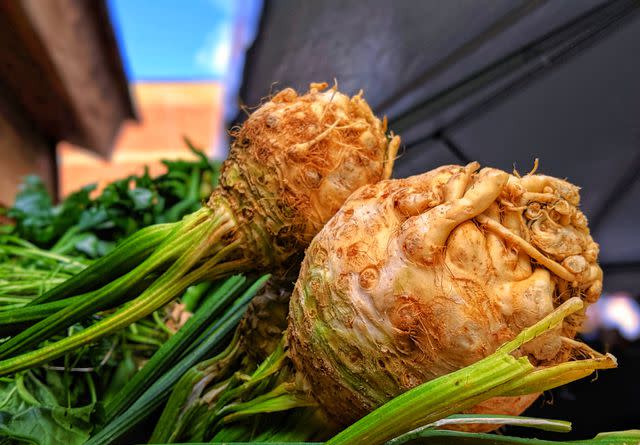Celeriac Nutrition: Not Quite Celery, But Close
Medically reviewed by Aviv Joshua, MS
Celeriac is an edible root vegetable sometimes referred to as celery root. It is a variety of celery that is grown for its edible roots instead of the stalks. Celeriac is related to celery, parsley, and parsnips.
Celeriac appears rough and covered in roots. It is usually an off-white color, and the inside flesh is white. Celeriac is rich in vitamins and minerals, including vitamin C, calcium, and potassium. Store celeriac in a cool, dry place like the pantry and enjoy it raw or cooked.
This article discusses celeriac nutrition facts, health benefits, and how to prepare it.

Dale Fornoff / Getty Images
Celeriac vs. Celery: Main Differences
Celeriac and celery may look similar, but they are harvested for different reasons. Celery plants are grown for their stalks, and celeriac plants are grown for their roots. They have a similar celery taste, with celeriac having a more earthy flavor.
Celery and celeriac can usually be used interchangeably in recipes. Celery is simple to prepare and only requires a quick rinse and chopping. However, celeriac needs a lot of peeling before it can be chopped up for recipes.
What Makes Celeriac Nutritious?
Celeriac is a nutritious root vegetable. One cup of raw celeriac contains:
Calories: 65.5
Fat: 0.47 grams (g)
Protein: 2.34 g
Carbohydrates: 14.4 g
Fiber: 2.81 g
Vitamin C: 12.5 milligrams (mg)
Vitamin K: 64 micrograms (mcg)
Vitamin B6: 0.257 mg
Calcium: 67.1 mg
Phosphorus: 179 mg
Potassium: 468 mg
Folate: 12.5 mcg
Unsuspecting Benefits of Celeriac
Celeriac is a hearty root vegetable that is packed with nutrients. It has several health benefits and may improve both your heart and digestive health.
Aids in Digestion
Celeriac is high in fiber. The body needs fiber to aid in digestion and metabolism. Eating a fiber-rich diet improves your digestion and helps prevent constipation.
Rich in Antioxidants
Celeriac is rich in antioxidants, compounds that fight free radical damage in the body. Antioxidants protect healthy cells from damage and lower the risk of certain chronic diseases.
Strengthens Bones
Celeriac is a good source of vitamin K. The body needs vitamin K to absorb calcium and prevent bone loss. A diet rich in vitamin K has been linked with a lower risk of bone fractures.
Protects Your Heart
Adding celeriac to your diet could improve your heart health. Celeriac is rich in vitamin C and potassium. Diets rich in vitamin C have a favorable effect on blood pressure. Having lower blood pressure puts less stress on the heart. Potassium can also regulate blood pressure and has been linked to a lower risk of stroke.
Lowers Cancer Risk
In addition to improving digestion, a high-fiber diet may lower the risk of cancer. Consuming fiber in celeriac may reduce the risk of certain types of cancer. The vitamin K in celeriac may also lower the risk of cancer.
Where Is Celeriac in the Grocery Store?
Celeriac is a vegetable and can be found in the produce section of the grocery store. Look for it near other root vegetables like turnips, parsnips, or potatoes. You may have more luck finding celeriac at your local farmer’s market.
When shopping for celeriac, look for firm and smooth bulbs. If they are very wrinkly, they may be old.
Different Ways to Use Celeriac
There is a wide variety of ways to use celeriac. It has a mild celery taste when raw, and the flavor turns slightly sweet after being roasted. Raw celeriac may have a somewhat bitter taste.
Celeriac is a root vegetable that can be used in place of other root vegetables like potatoes. Try preparing celeriac like you would potatoes, such as mashed, roasted, or fried. Add raw celeriac to salads or try pickling it.
Consider adding celeriac to the following dishes:
Soups
Stews
Sauces
Purees
Stir-fries
Gratins
To prepare celeriac, start by cutting off the end of the root. Then, peel off the tough outer skin. Once you’ve removed the peel, remove any dirt or rough spots.
Celeriac is considered in season in the fall and winter. It usually pairs well with other seasonal produce like kale, fennel, mushrooms, and apples.
Summary
Celeriac is a variety of celery grown for its edible roots. It is related to celery, parsley, and parsnips. Celery and celeriac have a similar taste. Celeriac can often be found at the grocery store or farmer’s market. It looks like a large bulb that is rough and covered in roots.
Celeriac contains several nutrients, including vitamins C and K, calcium, phosphorus, and potassium. Celeriac is high in fiber, which may improve digestive and heart health.
Celeriac can be enjoyed both raw and cooked. Try adding cooked celeriac to your favorite soups, stews, or sauces. Raw celeriac has a slightly bitter taste and adds a nice crunch to salads.
Read the original article on Verywell Health.

